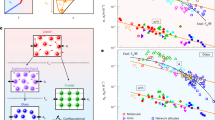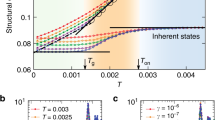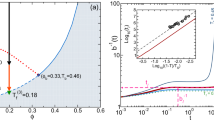Abstract
The conventional understanding of the glass transition is that the transition from glass to liquid appears as a dynamic process in which atoms or molecules relax cooperatively into the equilibrium phase. Here we show that—in contrast to this picture—isolated regions of liquid form within the glassy matrix and the nature of the glass transition at a given temperature depends on the ratio between the relaxation time of the glass, τglass, and the alpha relaxation time of the equilibrated liquid, τα. At temperatures at which τglass/τα is large, we observe that high-mobility regions transit directly into the equilibrated liquid and subsequently grow by dynamic facilitation before—or while—cooperative glass relaxation sets into play. On the contrary, at temperatures associated with smaller τglass/τα, the glass transition proceeds by cooperative relaxation dynamics throughout the material. This behaviour is independent of the experimental procedure or protocol used to produce the glass.
This is a preview of subscription content, access via your institution
Access options
Access Nature and 54 other Nature Portfolio journals
Get Nature+, our best-value online-access subscription
$29.99 / 30 days
cancel any time
Subscribe to this journal
Receive 12 print issues and online access
$209.00 per year
only $17.42 per issue
Buy this article
- Purchase on Springer Link
- Instant access to full article PDF
Prices may be subject to local taxes which are calculated during checkout




Similar content being viewed by others
Data availability
Data that support the plots within this paper and other findings of this study are available from the corresponding authors upon reasonable request. Source data are provided with this paper.
References
Angell, C. A., Ngai, K. L., McKenna, G. B., McMillan, P. F. & Martin, S. W. Relaxation in glassforming liquids and amorphous solids. J. Appl. Phys. 88, 3113–3157 (2000).
Charbonneau, P. & Tarjus, G. Decorrelation of the static and dynamic length scales in hard-sphere glass formers. Phys. Rev. E 87, 042305 (2013).
Coslovich, D. & Pastore, G. Understanding fragility in supercooled Lennard–Jones mixtures. I. Locally preferred structures. J. Chem. Phys. 127, 124504 (2007).
Ma, D., Stoica, A. D. & Wang, X. L. Power-law scaling and fractal nature of medium-range order in metallic glasses. Nat. Mater. 8, 30–34 (2009).
Ojovan, M. I. & Tournier, R. F. On structural rearrangements near the glass transition temperature in amorphous silica. Mater. (Basel) 14, 5235 (2021).
Ojovan, M. I. & Louzguine-Luzgin, D. V. Revealing structural changes at glass transition via radial distribution functions. J. Phys. Chem. B 124, 3186–3194 (2020).
Albert, S. et al. Fifth-order susceptibility unveils growth of thermodynamic amorphous order in glass-formers. Science 352, 1308–1311 (2016).
Janssen, L. M. C. Mode-coupling theory of the glass transition: a primer. Front. Phys. 6, 1–18 (2018).
Biroli, G. & Garrahan, J. P. Perspective: the glass transition. J. Chem. Phys. 138, 12A301 (2013).
Debenedetti, P. G. & Stillinger, F. H. Supercooled liquids and the glass transition. Nature 410, 259–267 (2001).
Hecksher, T. & Dyre, J. C. A review of experiments testing the shoving model. J. Non-Cryst. Solids 407, 14–22 (2015).
Stanzione, J. F., Strawhecker, K. E. & Wool, R. P. Observing the twinkling fractal nature of the glass transition. J. Non-Cryst. Solids 357, 311–319 (2011).
Mauro, J. C., Yue, Y., Ellison, A. J., Gupta, P. K. & Allan, D. C. Viscosity of glass-forming liquids. Proc. Natl Acad. Sci. USA 106, 19780–19784 (2009).
Lubchenko, V. Theory of the structural glass transition: a pedagogical review. Adv. Phys. 64, 283–443 (2015).
Lubchenko, V. & Wolynes, P. G. Theory of structural glasses and supercooled liquids. Annu. Rev. Phys. Chem. 58, 235–266 (2007).
Tarjus, G., Kivelson, S. A., Nussinov, Z. & Viot, P. The frustration-based approach of supercooled liquids and the glass transition: a review and critical assessment. J. Phys. Condens. Matter 17, 1143–1182 (2005).
Ediger, M. D. Spatially heterogeneous dynamics in supercooled liquids. Annu. Rev. Phys. Chem. 51, 99–128 (2003).
Wisitsorasak, A. & Wolynes, P. G. Dynamical heterogeneity of the glassy state. J. Phys. Chem. B 118, 7835–7847 (2014).
Wolynes, P. G. Spatiotemporal structures in aging and rejuvenating glasses. Proc. Natl Acad. Sci. USA 106, 1353–1358 (2009).
Vila-Costa, A. et al. Nucleation and growth of the supercooled liquid phase control glass transition in bulk ultrastable glasses. Phys. Rev. Lett. 124, 076002 (2020).
Lüttich, M. et al. Anti-aging in ultrastable metallic glasses. Phys. Rev. Lett. 120, 135504 (2018).
Zhao, J., Simon, S. L. & McKenna, G. B. Using 20-million-year-old amber to test the super-Arrhenius behaviour of glass-forming systems. Nat. Commun. 4, 1783 (2013).
Badrinarayanan, P., Zheng, W., Li, Q. & Simon, S. L. The glass transition temperature versus the fictive temperature. J. Non-Cryst. Solids 353, 2603–2612 (2007).
Moynihan, C. T., Lee, S.-K., Tatsumisago, M. & Minami, T. Estimation of activation energies for structural relaxation and viscous flow from DTA and DSC experiments. Thermochim. Acta 280–281, 153–162 (1996).
Keys, A. S., Garrahan, J. P. & Chandler, D. Calorimetric glass transition explained by hierarchical dynamic facilitation. Proc. Natl Acad. Sci. USA 110, 4482–4487 (2013).
Chandler, D. & Garrahan, J. P. Dynamics on the way to forming glass: bubbles in space–time. Annu. Rev. Phys. Chem. 61, 191–217 (2010).
Douglass, I. & Harrowell, P. Can a stable glass be superheated? Modelling the kinetic stability of coated glassy films. J. Chem. Phys. 138, 12A516 (2013).
Gutiérrez, R. & Garrahan, J. P. Front propagation versus bulk relaxation in the annealing dynamics of a kinetically constrained model of ultrastable glasses. J. Stat. Mech. Theory. Exp. 2016, 074005 (2016).
Lulli, M., Lee, C. S., Deng, H. Y., Yip, C. T. & Lam, C. H. Spatial heterogeneities in structural temperature cause Kovacs’ expansion gap paradox in aging of glasses. Phys. Rev. Lett. 124, 095501 (2020).
Jack, R. L. & Berthier, L. The melting of stable glasses is governed by nucleation-and-growth dynamics. J. Chem. Phys. 144, 244506 (2016).
Fullerton, C. J. & Berthier, L. Density controls the kinetic stability of ultrastable glasses. EPL 119, 36003 (2017).
Guiselin, B., Scalliet, C. & Berthier, L. Microscopic origin of excess wings in relaxation spectra of supercooled liquids. Nat. Phys. 18, 468–472 (2022).
Rodriguez-Tinoco, C., Gonzalez-Silveira, M., Ramos, M. A. & Rodriguez-Viejo, J. Ultrastable glasses: new perspectives for an old problem. Riv. Nuovo Cim. 45, 325–406 (2022).
Rodríguez-Tinoco, C. et al. Surface–bulk interplay in vapor-deposited glasses: crossover length and the origin of front transformation. Phys. Rev. Lett. 123, 155501 (2019).
Kearns, K. L. et al. Hiking down the energy landscape: progress toward the Kauzmann temperature via vapor deposition. J. Phys. Chem. B 112, 4934–4942 (2008).
Ràfols-Ribé, J., Gonzalez-Silveira, M., Rodríguez-Tinoco, C. & Rodríguez-Viejo, J. The role of thermodynamic stability in the characteristics of the devitrification front of vapour-deposited glasses of toluene. Phys. Chem. Chem. Phys. 19, 11089–11097 (2017).
Kearns, K. L., Ediger, M. D., Huth, H. & Schick, C. One micrometer length scale controls kinetic stability of low-energy glasses. J. Phys. Chem. Lett. 1, 388–392 (2010).
Sepúlveda, A., Swallen, S. F. & Ediger, M. D. Manipulating the properties of stable organic glasses using kinetic facilitation. J. Chem. Phys. 138, 12A517 (2013).
Ràfols-Ribé, J. et al. Kinetic arrest of front transformation to gain access to the bulk glass transition in ultrathin films of vapour-deposited glasses. Phys. Chem. Chem. Phys. 20, 29989–29995 (2018).
Hellman, F. Surface‐induced ordering: a model for vapor‐deposition growth of amorphous materials. Appl. Phys. Lett. 64, 1947 (1998).
Swallen, S. F. et al. Organic glasses with exceptional thermodynamic and kinetic stability. Science 315, 353–356 (2007).
León-Gutierrez, E. et al. In situ nanocalorimetry of thin glassy organic films. J. Chem. Phys. 129, 181101 (2008).
Leon-Gutierrez, E., Sepúlveda, A., Garcia, G., Clavaguera-Mora, M. T. & Rodríguez-Viejo, J. Stability of thin film glasses of toluene and ethylbenzene formed by vapor deposition: an in situ nanocalorimetric study. Phys. Chem. Chem. Phys. 12, 14693–14698 (2010).
Leon-Gutierrez, E., Sepúlveda, A., Garcia, G., Clavaguera-Mora, M. T. & Rodríguez-Viejo, J. Correction: stability of thin film glasses of toluene and ethylbenzene formed by vapor deposition: an in situ nanocalorimetric study. Phys. Chem. Chem. Phys. 18, 8244–8245 (2016).
Beasley, M. S., Bishop, C., Kasting, B. J. & Ediger, M. D. Vapor-deposited ethylbenzene glasses approach ‘ideal glass’ density. J. Phys. Chem. Lett. 10, 4069–4075 (2019).
Rodríguez-Tinoco, C., Ràfols-Ribé, J., González-Silveira, M. & Rodríguez-Viejo, J. Relaxation dynamics of glasses along a wide stability and temperature range. Sci. Rep. 6, 1–8 (2016).
Sepúlveda, A., Tylinski, M., Guiseppi-Elie, A., Richert, R. & Ediger, M. D. Role of fragility in the formation of highly stable organic glasses. Phys. Rev. Lett. 113, 1–5 (2014).
Cubeta, U. S. & Sadtchenko, V. Glass softening kinetics in the limit of high heating rates. J. Chem. Phys. 150, 094508 (2019).
Louzguine-Luzgin, D. V. Vitrification and devitrification processes in metallic glasses. J. Alloys Compd. 586, S2–S8 (2014).
Dalal, S. S., Walters, D. M., Lyubimov, I., de Pablo, J. J. & Ediger, M. D. Tunable molecular orientation and elevated thermal stability of vapor-deposited organic semiconductors. Proc. Natl Acad. Sci. USA 112, 4227–4232 (2015).
Rodríguez-Tinoco, C., Rams-Baron, M., Rodríguez-Viejo, J. & Paluch, M. Emergence of a substrate-temperature-dependent dielectric process in a prototypical vapor deposited hole-transport glass. Sci. Rep. 8, 1–10 (2018).
Berthier, L. & Biroli, G. Theoretical perspective on the glass transition and amorphous materials. Rev. Mod. Phys. 83, 587–645 (2011).
Walters, D. M., Richert, R. & Ediger, M. D. Thermal stability of vapor-deposited stable glasses of an organic semiconductor. J. Chem. Phys. 142, 134504 (2015).
Rodríguez-Tinoco, C., Ràfols-Ribé, J., González-Silveira, M. & Rodríguez-Viejo, J. Relaxation dynamics of glasses along a wide stability and temperature range. Sci. Rep. 6, 35607 (2016).
Olson, E. A., Efremov, M. Y., Zhang, M., Zhang, Z. & Allen, L. H. The design and operation of a MEMS differential scanning nanocalorimeter for high-speed heat capacity measurements of ultrathin films. J. Microelectromech. Syst. 12, 355–364 (2003).
Efremov, M. Y. et al. Thin-film differential scanning nanocalorimetry: heat capacity analysis. Thermochim. Acta 412, 13–23 (2004).
Lopeandía, A. F. et al. Sensitive power compensated scanning calorimeter for analysis of phase transformations in small samples. Rev. Sci. Instrum. 76, 065104 (2005).
Rodríguez-Viejo, J. & Lopeandía, A. F. in Fast Scanning Calorimetry (eds Schick, C. & Mathot, V.) 105–149 (Springer, 2016).
Johari, G. P. Comment on ‘Glass transition in pure and doped amorphous solid water: an ultrafast microcalorimetry study’. J. Chem. Phys. 127, 157101 (2007).
Cavagna, A. Supercooled liquids for pedestrians. Phys. Rep. 476, 51–124 (2009).
Wojnarowska, Z. et al. Broadband dielectric relaxation study at ambient and elevated pressure of molecular dynamics of pharmaceutical: indomethacin. J. Phys. Chem. B 113, 12536–12545 (2009).
Busch, R., Bakke, E. & Johnson, W. L. Viscosity of the supercooled liquid and relaxation at the glass transition of the Zr46.75Ti8.25Cu7.5Ni10Be27.5 bulk metallic glass forming alloy. Acta Mater. 46, 4725–4732 (1998).
Angell, C. A. Entropy and fragility in supercooling liquids. J. Res. Natl Inst. Stand. Technol. 102, 171–185 (1997).
Acknowledgements
J.R.-V. and M.G.-S. acknowledge grant MAT2016-79759-R funded by MCIN/AEI/ 10.13039/501100011033 and ‘ERDF A way of making Europe’, and grant PID2020-117409RB-I00 funded by MCIN/AEI/10.13039/501100011033. C.R.-T. is a Serra Hunter Fellow. The ICN2 was funded by the CERCA programme/Generalitat de Catalunya. The ICN2 was supported by the Severo Ochoa Centres of Excellence Programme, funded by the Spanish Research Agency (AEI, grant no. SEV-2017-0706). All authors acknowledge Ll. Abad and IMB-CNM-CSIC for the fabrication of the nanocalorimeters.
Author information
Authors and Affiliations
Contributions
A.V.-C., M.G.-S. and J.R.-V. conceived and designed the experiments. A.V.-C. and M.R.-L. performed the experiments. All the authors contributed to the analysis of the data and discussed the results. M.G.-S., A.V.-C., C.R.-T. and J.R.-V. wrote the paper. M.G.-S. and J.R.-V. supervised the project.
Corresponding authors
Ethics declarations
Competing interests
The authors declare no competing interests.
Peer review
Peer review information
Nature Physics thanks the anonymous, reviewer(s) for their contribution to the peer review of this work.
Additional information
Publisher’s note Springer Nature remains neutral with regard to jurisdictional claims in published maps and institutional affiliations.
Supplementary information
Supplementary Information
Supplementary Figs. 1 and 2 and Discussion.
Source data
Source Data Fig. 2
Specific heat data and relaxation/transformation time.
Source Data Fig. 3
Specific heat data and relaxation/transformation time.
Source Data Fig. 4
Specific heat data and relaxation/transformation time.
Rights and permissions
Springer Nature or its licensor holds exclusive rights to this article under a publishing agreement with the author(s) or other rightsholder(s); author self-archiving of the accepted manuscript version of this article is solely governed by the terms of such publishing agreement and applicable law.
About this article
Cite this article
Vila-Costa, A., Gonzalez-Silveira, M., Rodríguez-Tinoco, C. et al. Emergence of equilibrated liquid regions within the glass. Nat. Phys. 19, 114–119 (2023). https://doi.org/10.1038/s41567-022-01791-w
Received:
Accepted:
Published:
Issue Date:
DOI: https://doi.org/10.1038/s41567-022-01791-w
This article is cited by
-
Real-time microscopy of the relaxation of a glass
Nature Physics (2023)
-
Devitrification caught on film
Nature Physics (2023)
-
Depletion of two-level systems in highly stable glasses with different molecular ordering
Communications Physics (2023)



